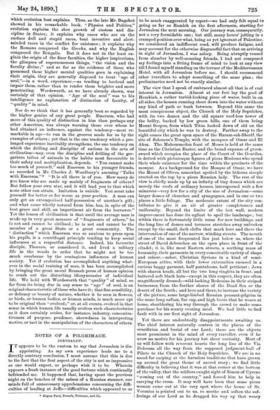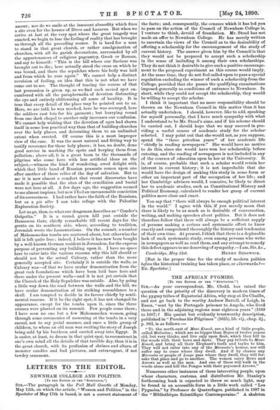NOTES 'OF A PILGRIMAGE.
JERIJBALEY.
IT appears to be the custom to say that Jerusalem is dis- appointing. As my own experience leads me to a directly contrary conclusion, I must assume that this is due -to the fact that the first aspect of the city is not so impressive as one would expect, or perhaps wish it to be. Wherein appears a fresh instance of the good fortune which continually befriended me. It happened that, having spent the previous night on the benches of the saloon of a Russian steamer, our minds full of unnecessary apprehensions concerning the diffi- culties of landing at Jaffa—difficulties which appeared to us
• Kogan Paul, Trench, Trrtbner, and Co.
to be ranch exaggerated by report—we bad only felt equal to going as far as Ramleh on the first afternoon, starting for Jerusalem the next morning. Our journey was, consequently, not a very formidable one; but still, many hours' jolting in a cramped position over what, being as yet ignorant of Palestine, we considered an indifferent road, will produce fatigue, and may account for the otherwise disgraceful fact that on arriving in sight of Jerusalem, I was asleep. Being abruptly roused from slumber by well-meaning friends, I had not composed my feelings into a fitting frame of mind to look at any view till I found myself standing on the terrace of the Mediterranean Hotel, with all Jerusalem before me. I should recommend other travellers to adopt something of the same plan ; the preliminaries need not be exactly similar.
The view that I speak of embraced almost all that is of real interest in Jerusalem. Almost at our feet lay the pool of Hezekiah, a rather turbid-looking piece of water, built in on all sides, the houses running sheer down into the water without any kind of path or bank between. Beyond this came the most conspicuous object, the Church of the Holy Sepulchre, with its two domes and the old square roof-less tower of the belfry, backed by low green hills, one of them being Mount Scopus, from which Titus looked down of old on the beautiful city which he was to destroy. Farther away to the right comes the great open space of the Haram-esh-Sherif, the site of Solomon's Temple, with the mosques of Omar and El Aksa. The Mahommedan feast of Moses is held at the same time as the Christian Easter, and the broad expanse of green- sward which occupies the place of the Court of the Gentiles, is dotted with picturesque figures of pious Moslems who spend their whole existence for the time within the precincts of the mosque. As a background for the Mosque of Omar, we have the Mount of Olives, somewhat spoiled by the hideous steeple erected on the top by a pious Russian lady. The rest of the view is chiefly made up by an infinity of tiny domes which are merely the roofs of ordinary houses, interspersed with a few minarets—very few for a city of the size of Jerusalem—some larger domes of churches and synagogues, and in one or two places a little foliage. The moderate extent of the city con- tributes to give it an air of greater completeness and uniformity. Beyond the limits of the last wall, modern improvement has done its ugliest to spoil the landscape ; but within there is fortunately little room for new buildings, and the long line of domes and terraces stretches away unbroken except by the small, dark clefts that mark here and there the intervention of one of the narrow, winding streets. The mouth of one of the most frequented lies just below us, where the street of David debouches on the open place in front of the citadel ; it is, like most Eastern streets, a seething mass of humanity, their garments in every conceivable variety of shape and colour,—sober, Christian Syrians in a kind of semi- European attire, with their lower extremities encased in a curious baggy garment, half pantaloons, half petticoat ; Jews with shaven heads, all but the two long ringlets in front, and battered soft black hats—except in this respect, they are often magnificently dressed—wild-looking Bedouins in their striped burnouses, from the further shores of the Dead Sea or the desert of the South ; and here and there, to increase the variety of the picture, some large-limbed Russian peasant-pilgrim in the same long caftan, fur cap, and high boots that he wears at home, shouldering his way through the crowd to make some purchase for his scanty evening meal. We had little to find fault with in our first sight of Jerusalem.
Yet there are undoubtedly disappointments awaiting us. The chief interest naturally centres in the places of the crucifixion and burial of our Lord; these are the objects most prominent in the mind of every traveller, even if he avow no motive for his journey but sheer curiosity. Most of us will follow with reverent hearts the long line of the Via Dolorosa all the way from the supposed judgment-hall of Pilate to the Church of the Holy Sepulchre. We are in no mood for carping at the harmless traditions that have grown up around the great theme of sacred story ; we find little difficulty in believing that it was at that corner at the bottom of the valley, that the soldiers caught sight of Simon of Cyrene "coming out of the country," and forced him to help in carrying the cross. It may well have been that some pions woman came out at the very spot where the house of St. Veronica is pointed out to us, to soothe and soften the suf- ferings of our Lord as he dragged his way up that weary ascent; nor do we smile at the innocent absurdity which fixes a site even for the houses of Dives and Lazarus. But when we arrive at last at the very spot where the great tragedy was enacted, we begin to lose the feeling of reality that has brought us through all the preceding scenes. It is hard for a man to stand in that great church, or rather amalgamation of churches, with all its garish decorations, surrounded by all the appurtenances of religious pageantry, Greek or Roman, and say to himself : "This is the hill where our Saviour was brought out to die ; here actually stood the cross on which he was bound, and there the sepulchre where his body was laid and from which he rose again." We cannot help a distinct revulsion of feeling, an idea that this is not what we have come out to see. The thought of tracing the course of that last procession is given up, as we find each sacred spot en- cumbered with all the paraphernalia of devotion distracting the eye and entirely obliterating all sense of locality. It is true that every detail of the place may be pointed out to us. Here, we are told, he was mocked, here he was scourged, here the soldiers cast lots for his garment ; but hurrying round from one dark chapel to another only increases our confusion. We cannot help wishing that the devotion of ages had shown itself in some less practical way than that of building churches over the holy places, and decorating them to an unlimited extent when erected. Of course this is a most improper view of the case. It was the most natural and fitting way to testify reverence for these holy places ; it has, no doubt, done good service in marking the spots and keeping them from pollution ; above all, it is a great boon to the thousands of pilgrims who come here with less artificial ideas on the subject,—witness the kind of wondering, awed delight with which that little band of Russian peasants comes upon one after another of these relics of the day of salvation. But to me it is now almost a comfort that recent discoveries have made it possible that the sites of the crucifixion and burial were not here at all. A few days ago, the suggestion seemed to me almost impious, but now I feel an unreasonable conviction of its correctness. I had rather have the faith of the Russians, but as a pis alter I can take refuge with the Palestine Exploration Society.
Let us go, then, to what our dragoman describes as" Conder's Golgotha." It is a. round, green hill just outside the Damascus Gate, chiefly remarkable till recent days for the grotto on its southern side, where, according to tradition, Jeremiah wrote the Lamentations. On the summit, a number of Mahommedan tombs are scattered about, but otherwise the hill is left quite free ; indeed, I believe it has now been bought by a well-known German resident in Jerusalem, for the express purpose of preventing any building upon it. I have no space here to enter into the various reasons why this hill should or should not be the actual Calvary, rather than the more generally accepted site. Certainly it is outside the walls, as Calvary was—of that we have ocular demonstration from the great rock foundations which have been laid bare here and there under the present walls—and it is not yet certain that the Church of the Holy Sepulchre was outside. Also, by going a little way down the road between the walls and the hill, we have ocular demonstration of its striking resemblance to a skull. I am tempted to decide in its favour chiefly by senti- mental reasons. If it be the right spot, it has not changed its appearance, except for the tombs upon it, since the three crosses were planted on its summit. Few people come there; I have seen no one but a few Itahommedan women, going through some ceremonies of mourning at the tombs in a very casual, not to say jovial manner, and once a little group of children, to whom an old man was reciting the story of Joseph being sold by his brethren and carried away into Egypt. It is easier, at least, to dream in that quiet spot, to reconstruct in one's own mind all the details of that terrible day, than it is in the great church, with its profusion of shrines and altars, of monster candles and bad pictures, and extravagant, if not tawdry ornament.



































 Previous page
Previous page